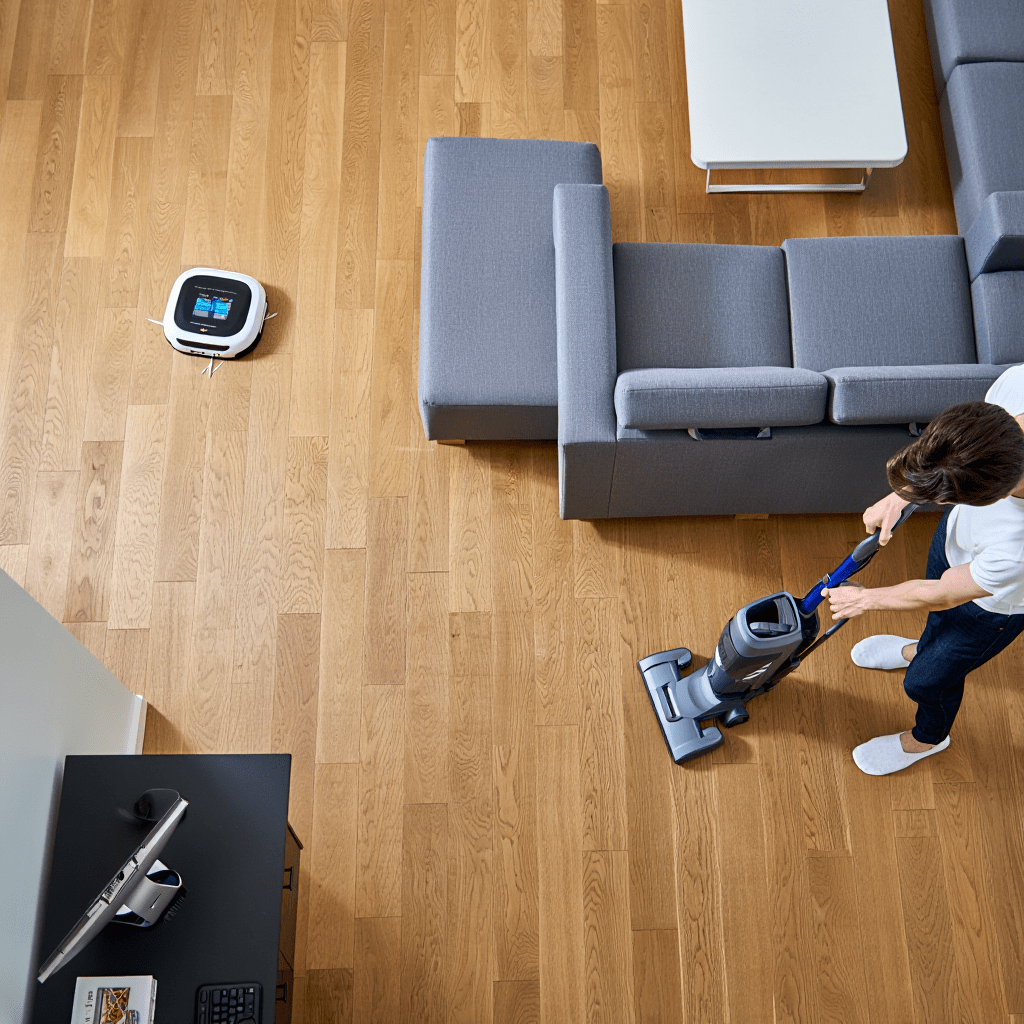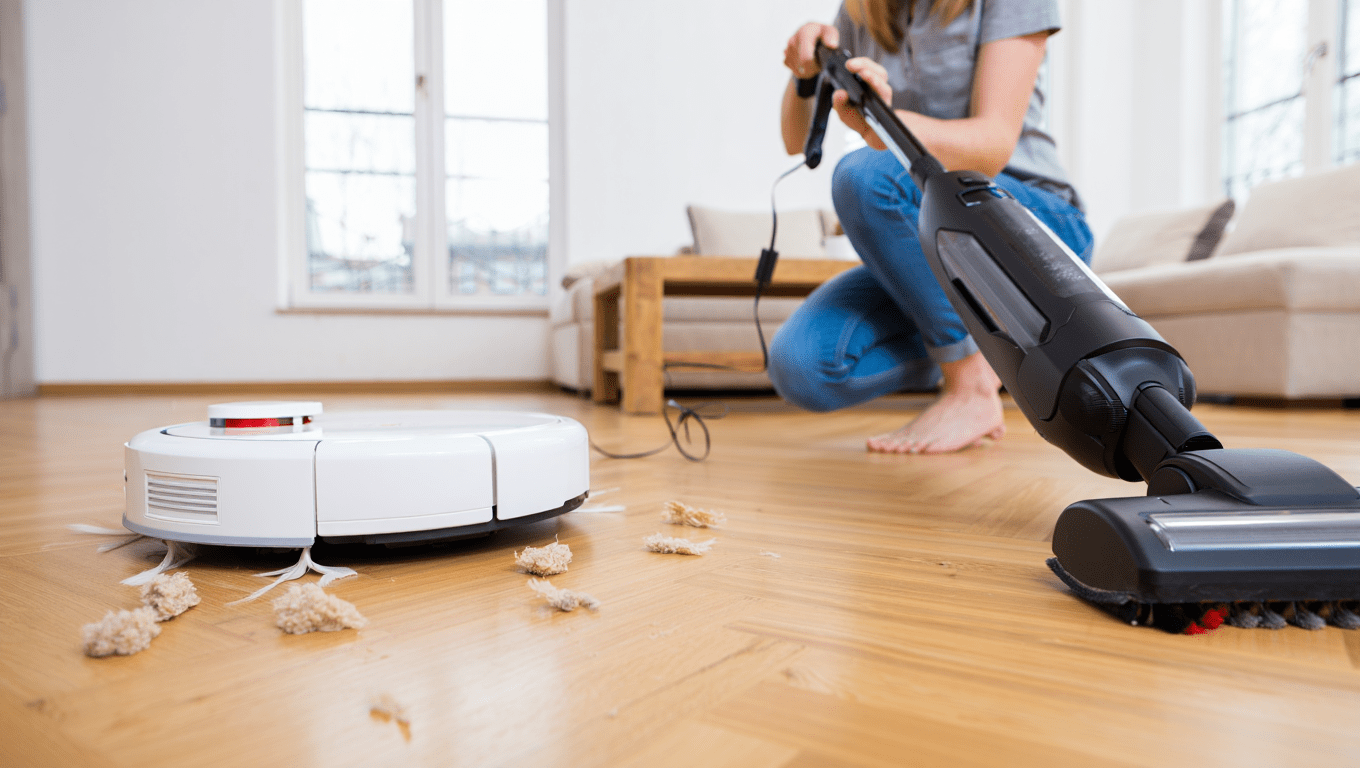Vacuum technology has come a long way in recent years, and homeowners now face a common question: Should you invest in a robot vacuum or stick with a traditional model? While robot vacuums promise hands-free convenience, traditional vacuums are often praised for their deep-cleaning power. Each has strengths and drawbacks that depend on your lifestyle, flooring, pets, and budget.
This guide explores how robot and traditional vacuums compare in performance, cost, maintenance, and long-term reliability. By the end, you’ll know which option best suits your cleaning routine and whether a hybrid approach might be the smartest solution.

Why Does This Comparison Matters?
Before we break down the details, it’s important to understand why choosing the right vacuum type is more than just preference. The wrong vacuum can mean wasted money, reduced air quality, and even premature replacement. Let’s explore why this debate matters.
Cleaning Needs and Lifestyle Fit
Robot vacuums are designed for convenience—they handle routine maintenance cleaning without much input. Traditional vacuums, on the other hand, provide a more thorough clean, especially on thick carpets or in large households.
For example, if you live in a pet-friendly home with kids, a traditional upright might be necessary to pull out embedded dirt, while a robot vacuum works best for daily upkeep.
Cost and Long-Term Value
A decent robot vacuum can cost anywhere from $200 to over $1,000 for high-end models like Roomba s9+. Traditional vacuums range from $100 budget uprights to $700+ premium models like Miele.
While robots save time, repairs and battery replacements can add hidden costs. Traditional vacuums may require bags and filters, but they’re often cheaper to maintain long-term.
Cleaning Performance Compared
When buying a vacuum, performance is the number one concern. Let’s compare suction power, surface coverage, and reliability.
Suction Power and Dirt Removal
Traditional vacuums—upright, canister, and stick—still outperform robots in raw suction. A Dyson upright, for instance, provides 200–300 air watts, while most robot vacuums hover around 20–50 air watts. That means robots excel at surface-level cleaning but struggle with deep carpets.
However, newer robots with auto-adjust cleaning heads and turbo modes (like Roborock S7) can keep up on hard floors and low-pile rugs. Still, households with thick carpets should rely on traditional vacuums for deep cleaning sessions.
Coverage and Efficiency
Robot vacuums map rooms and follow systematic patterns, ensuring full coverage over time. Traditional vacuums depend on user effort—if you skip corners, dirt remains. Yet, robots sometimes miss tight spaces, stairs, or cluttered zones.
Pairing both types ensures efficiency: robots handle daily dust, while traditional models tackle periodic deep cleans.
Maintenance and Servicing
One major factor homeowners overlook is how much maintenance each type requires.
Robot Vacuum Maintenance
Robot vacuums need frequent upkeep despite their automation. You’ll need to:
- Empty dustbins daily or every few uses.
- Clean sensors and charging contacts weekly.
- Replace side brushes, rollers, and HEPA filters every 6–12 months.
- Budget for battery replacement every 2–3 years (cost: $50–$150).
Traditional Vacuum Maintenance
Traditional vacuums require less frequent but more thorough servicing:
- Replace bags (if bagged) every 1–2 months.
- Wash or replace filters every 6–12 months.
- Replace belts or brush rolls when worn.
- Professional servicing ($50–$100) every 1–2 years to extend lifespan.
Cost comparison: Over 5 years, robot vacuums may cost more in upkeep due to batteries and frequent part changes, while traditional vacuums rely mainly on bags and filters.
Convenience and Usability
This is where robot vacuums shine, but it’s not always one-sided.
Robot Vacuums: Set It and Forget It
Robots provide unmatched convenience. With Wi-Fi control, scheduling, and self-emptying bases, they can run daily while you’re at work. For busy families or elderly homeowners, this is a huge advantage. However, they can’t climb stairs, and tangled cords or cluttered floors can disrupt operation.
Traditional Vacuums: Manual but Powerful
Traditional vacuums require effort, but they’re versatile. You can instantly clean stairs, upholstery, and car interiors—something robots can’t do. Uprights and canisters also have attachments for curtains, ceiling fans, and furniture.
For homeowners who don’t mind manual cleaning, the control and versatility outweigh the convenience of robots.
Cost of Ownership
Price is more than just the upfront cost—it’s about long-term spending.
Robot Vacuum Costs
- Entry-level: $200–$300 (limited features, random navigation).
- Mid-range: $400–$600 (mapping, stronger suction, app controls).
- Premium: $700–$1,200 (self-emptying, mopping, smart mapping).
- Long-term: Battery + brush replacements can add $200–$400 every few years.
Traditional Vacuum Costs
- Budget: $100–$250 (basic upright or stick).
- Mid-range: $250–$500 (HEPA filtration, strong suction).
- Premium: $600–$900+ (high-end Miele or Kirby).
- Long-term: Bags and filters ($30–$50/year), with fewer expensive repairs.
Durability and Lifespan
Choosing between a robot vacuum and a traditional vacuum also means thinking about how long each will last and what kind of reliability you can expect.
Robot Vacuums: Shorter Lifespan but Easy Replacements
Most robot vacuums last 4–6 years with proper care. The biggest wear points are batteries, wheels, and sensors. Batteries usually need replacing every 2–3 years, and when sensors fail, repairs can be costly. Brands like iRobot and Roborock offer replacement parts, but many off-brand models lack long-term support.
Traditional Vacuums: Built for Longevity
A well-maintained upright or canister vacuum can last 8–12 years—premium models like Miele or Sebo often run 15+ years with servicing. Replacement parts such as belts, bags, and filters are inexpensive and widely available. For homeowners who want an appliance that can last a decade, traditional vacuums are the safer bet.
Common Mistakes Owners Make
No matter which type you choose, misuse or neglect can shorten its life.
Overloading Robot Vacuums
Owners often let dustbins overfill, which reduces suction and strains the motor. Another mistake is letting clutter like cords or socks tangle the brushes, leading to sensor errors.
Ignoring Filter Changes in Traditional Vacuums
Filters are critical for both vacuum types, but traditional vacuums with neglected filters lose suction and push dust back into the air. Many owners wait until the vacuum “smells” before replacing filters—by then, the motor may already be stressed.
Using the Wrong Parts
Cheaper aftermarket filters, bags, or batteries don’t always fit properly and may reduce suction or lifespan. OEM parts ensure performance and are often worth the small extra cost.
Practical Tips for Choosing and Using Your Vacuum
Here’s how to make the most of whichever vacuum type you prefer.
Tips for Robot Vacuums
- Declutter floors before runs to avoid tangles.
- Schedule cleaning daily for light maintenance rather than occasional deep cleaning.
- Clean brushes weekly if you have pets.
- Invest in a self-emptying base if you dislike frequent bin emptying.
Tips for Traditional Vacuums
- Replace bags early—don’t wait until they’re packed full.
- Wash filters quarterly and replace annually.
- Use the right attachment for upholstery, stairs, and crevices.
- Book professional servicing every 18–24 months to extend motor life.
Hybrid Approach: The Best of Both Worlds
Many households now combine both types:
- A robot vacuum runs daily for dust and crumbs.
- A traditional vacuum handles carpets, stairs, and seasonal deep cleaning.
This approach balances convenience with power, ensuring every corner of the home stays clean.
Conclusion
When comparing robot vacuums vs. traditional vacuums, it’s clear that both have distinct advantages. Robots shine in convenience, automation, and daily dust control, while traditional vacuums deliver unmatched suction, deep cleaning, and long-term durability. For busy homeowners, a robot vacuum may save time, but allergy sufferers and pet owners still benefit from the power of traditional models.
Ultimately, the best choice depends on your flooring, budget, and cleaning expectations. And for many households, combining both types offers the most balanced solution—daily maintenance from a robot, and deep cleaning with a traditional vacuum when it truly counts.
FAQs
Are robot vacuums as powerful as traditional vacuums?
No. Robot vacuums are excellent for daily upkeep but generally have weaker suction. For deep carpets or heavy pet hair, traditional vacuums are still superior.
How long do robot vacuums last compared to traditional models?
Robot vacuums typically last 4–6 years, while traditional vacuums average 8–12 years. Premium models with proper servicing can last over 15 years.
Do robot vacuums work well with pets?
Yes, but with caveats. Robots pick up daily fur and dander, but their bins fill quickly. For heavy shedders, you’ll still need a strong upright vacuum.
Which type is more cost-effective long term?
Traditional vacuums are generally more cost-effective, with fewer high-ticket repairs. Robot vacuums save time but can become expensive with battery and part replacements.
Should I get both a robot and traditional vacuum?
Yes, if budget allows. Robots provide convenience, while traditional vacuums handle deep cleaning and specialty tasks. Many families find this hybrid solution most practical.
